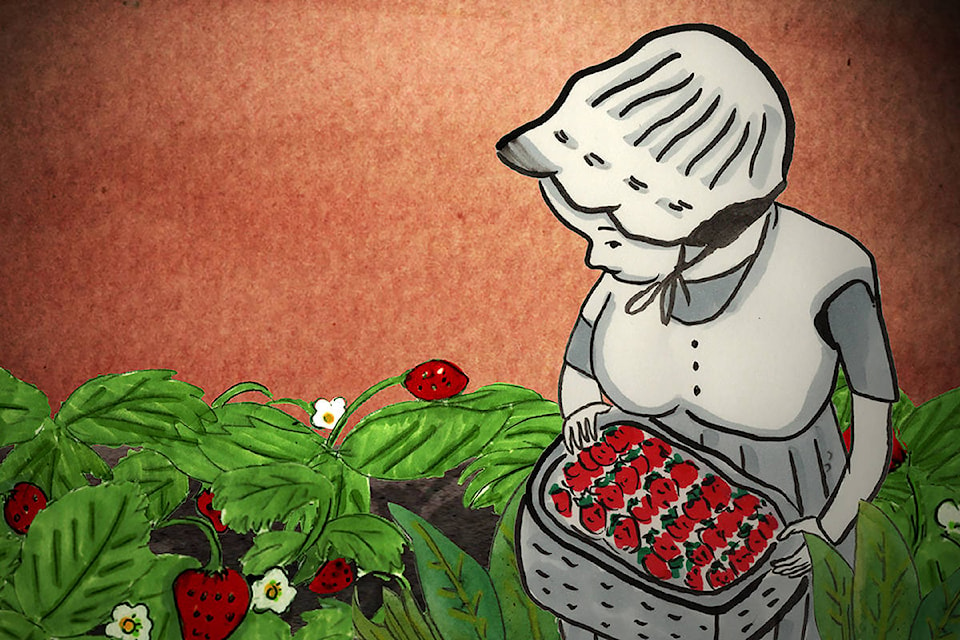Surrey Art Gallery’s summer exhibits aim to “make invisible Japanese Canadian histories visible again.”
Cindy Mochizuki’s solo show “Autumn Strawberry” opens Saturday (June 26), as does Henry Tsang’s “Hastings Park,” both until Aug. 28.
Pre-booking is required to visit the gallery over the next couple of months, minimum, with entrance limited to Saturday from 10 a.m. to 3 p.m., and Tuesday, Wednesday and Thursday from 4 to 7 p.m. For details, call 604-501-5566.
Mochizuki’s multimedia installation takes visitors back in time to Japanese-Canadian farms, in the years prior to the Second World War, with a focus on Surrey’s Strawberry Hill area.
“My grandparents had berry farms in the Walnut Grove, Langley area, so the whole ‘Japanese-Canadians in agriculture and berry farms’ angle has a personal connection to my own history,” Mochizuki told the Now-Leader.
Two summers ago, the Vancouver-based artist took residency at the gallery’s TechLab to collect berry farming-related histories and stories from Japanese-Canadians in Surrey and the Fraser Valley.
From that, she threaded together a series of short vignettes imagined through a 60-minute animation (hand-painted and digital), projected onto the gallery’s walls and screens. She combined real with imagined characters and storylines, in keeping with an art practice of historical re-creation.
“Back in 2019 I met with with dozens of nisei and sansei (second- and third-generation Japanese-Canadians), many now in their 80s and 90s, so not a lot of them are still alive to remember that time,” Mochizuki explained.
“They would have been little kids in the farms that their parents and grandparents had owned, and I started collecting memories and conversations about their time. We’re working with time and memory here, so it’s what they can remember as seniors, from 1930 to around 1942 – their time as kids.”
As people heard about the project and began contacting Mochizuki, the project started taking off.
“If they couldn’t come to Surrey, I’d connect with them in other ways,” she recalled. “I’d get these emails saying, ‘I have a story for you, I remember so-and-so had a farm on this Surrey street, and I remember a man with a leghorn chicken and could find him for you.’ All this flurry of activity started happening.”
If not for the pandemic, the show would welcome people to “take it all in for an extended time,” the artist explained. But now, admission numbers are limited.
“Originally the idea was to have some of the people, the storytellers, return to perform,” Mochizuki added. “A second part of the project involves me working with a choreographer (with 605 Collective). As audience member you’d have this sort of intimate walk-through of these worlds.”
(Story continues below image)
PICTURED: Henry Tsang’s “Hastings Park” show involves thermal-imaging of buildings at the East Vancouver park. (submitted photo/SAG)
Animation is probably the perfect medium for “Autumn Strawberry,” Mochizuki said, “because there are some things that a camera never documented, and so we needed to kind of bend and transform things. With the pandemic we can’t do that live element, but we are bringing back some of the descendants, the grandchildren, of those who were berry farmers, and they’ll be doing some performance for the camera that will end up becoming a dance film afterward. It’s multifaceted, with lots of collaborators involved.”
On Saturday, July 17 starting at 7 p.m., Mochizuki and Tsang will talk about their work during an hour-long event on Facebook Live and Youtube. Look for details on surrey.ca/artgallery.
With “Hastings Park,” Tsang picks up where Mochizuki leaves off, in a multimedia installation of photographs and projections of four buildings at Vancouver’s Hastings Park. There, in 1942, roughly 8,000 Japanese-Canadians were marshalled and detained prior to being sent to internment and labour camps in the B.C. interior, Alberta, Manitoba and Ontario. Among the four structures is the livestock building, a place associated nowadays with the Pacific National Exhibition’s popular pig races and petting zoo.
“Tsang used a thermal imaging camera to create his images based in part on the compositions and staging of Leonard Frank’s documentary photographs of the Japanese-Canadian internment in this temporary incarceration site,” says an event advisory. “A thermal imaging camera is typically used in the construction industry to display differences in temperature by detecting light rays that are invisible to the human eye. Such photographs can reveal leaks or cracks in a building.”
In using the camera, Tsang says, “I’m asking the buildings to remember when they housed 8,000 people. This camera exposes not only the current condition of the buildings, but also the past and hidden histories inscribed within. It can see things we can’t.”
This summer, also on view at Surrey Art Gallery is “Arts 2021,” an annual juried art show organized by the Arts Council of Surrey. This year’s exhibit showcases more than 50 paintings, drawings, sculptures, textile arts and digital art, in and on the gallery’s halls and walls.
• READ MORE ABOUT ‘ARTS 2021’: More than 50 different art works on display at Surrey Arts Centre.
tom.zillich@surreynowleader.com
Like us on Facebook Follow us on Instagram and follow Tom on Twitter
